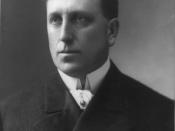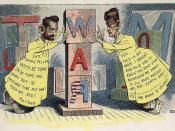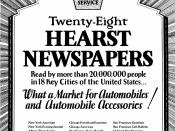The writings of William Randolph Hearst's newspaper The New York Journal had a profound effect on the American public during the era of Yellow Journalism. From 1895, when Hearst first purchased the paper, to 1966, the year of the Journal's last printing, scandalous articles about everything from the War with Spain to American politics would leave many spellbound and, at the same time, hungry for more. Most often, these writings published in the Journal were exaggerated and full of misinformation. Still, the content of these articles managed to change the opinions of the public in a time when the real details of such events were rarely revealed.
The man behind the Journal's initial success was William Randolph Hearst, who was born in San Francisco in 1863. Hearst began his journalism career in 1885 when he took over ownership of a failing paper, the San Francisco Examiner. The previous owner, Hearst's own father (who had very little interest in the paper and only agreed to buy it so he could use it to promote his career as a senator) came under criticism from his son for the paper's uninteresting features.
Once receiving the paper, young Will Hearst re-made the Examiner using many of the same tactics as fellow newspaper owner Joseph Pulitzer, whose work Hearst greatly admired, used to sell copies of the New York World. Within a few years, the Examiner became highly popular, mostly due to Hearst's management of the newspaper. Of course, this was only the beginning for Hearst's success as an editor.
In 1895, hearing about the large journalism scene in New York City, Hearst left San Francisco and headed east. Before long, he found and bought another dull newspaper, the New York Journal, which he knew he could regenerate. To compete with the already widely...


